|
|
|
|
|
|
|
|
|
|
|
|
 |
|
|
Some folks won't agree. However, in my experience, the crucial difference between music lovers and audiophiles is that the former listen to good music regardless of recording quality -- lots of it -- and always finish tracks to their very end. They may even -- barbarians -- talk during the music because they're having so much fun. They don't fret over setup minutiae. When asked what it sounds like, they don't rattle off reams of test score observations. Rather, they comment on emotional reactions. They revel in the artist's voice or instrumental delivery. They write down CD titles to regulate their wallets of unhealthy fiscal congestion while hitting their local music haunts afterwards.
My short list of new aural discoveries chez Stippich, and compliments of all attendees, includes: Ahn-Plugged by the Asian string sisters The Ahn Trio [EMI Classics]; the ambient/techno Head On by Super Collider [The Medicine Label]; Houndog on Legacy/Columbia; the sugarcoated baritone insinuations of Ballads, Blues & Bey by Andy Bey [Evidence]; Strange Place for Snow by Swedish Jazz trio E.S.T. [Superstudio Gul/Columbia]; Poses by Rufus Wainright [Dreamworks]; Largo by Brad Mehldau [Warner Bros.]; Restless on the Farm by dobro phenomenon Jerry Douglas [Sugar Hill]; and baroque works by Jordi Savall on Ostinato - Hesperion XXI [AliaVox].
|
|
|
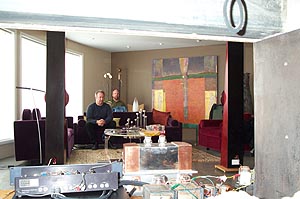 |
<
The listening arena as seen through the fire place |
|
 |
|
|
>
The Abbys set up in the near-field (middle of the room)
|
|
|
|
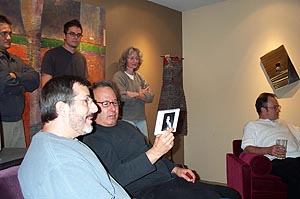 |
<
Californian Jay: "This shit's the shit, no shit." |
|
 |
|
|
>
Standing room only
|
|
|
|
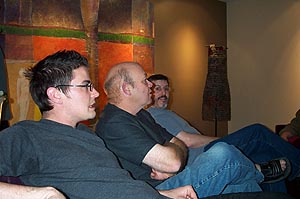 |
<
Josh: "The 10 is perhaps the best triode ever made." |
|
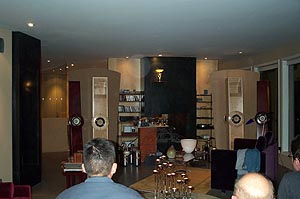 |
|
|
>
Do shiners count as reflective surfaces?
|
|
|
|
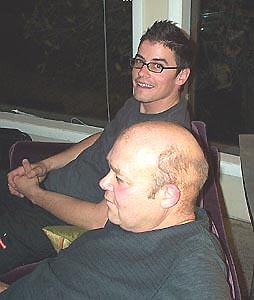 |
<
Josh: "My hair stands on end. It knows a good thing when it hears it."
Thinks Dave to himself: "I hear just fine without it." |
|
 |
|
|
>
The young maestro with his new preamp
|
|
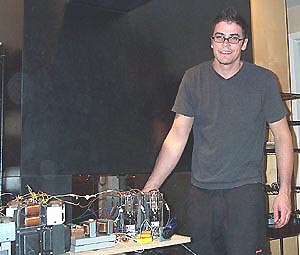 |
|
|
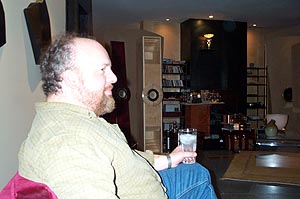 |
<
Thinks Terry: "Bearded men hear more yet." (Being a mind reader, I gotta agree.) |
|
|
|
>
Last man standing.
|
|
 |
|
I had auditioned Lowther-based single-driver speakers before. While I did perceive promise of unmitigated directness, I couldn't stomach their limitations in treble and bass extension. Yet, these two Cain-squared models suffered no such joy dampers. While the lowest octave was only hinted at (also remember that in this setup, they lacked a solid rearwall for reinforcement), the midbass was as punchy, fleshed out and potent as a champion boxer.
Missing treble? I didn't hear anything amiss. Rather, I was truly shocked - by the nothing-but-the-truth of timbre, by the organic ease of presentation, by the gargantuan and tall soundstage, by the seemingly limitless, uncompressed output potential and a super-liquid, ballsy quality whose LF prowess was clearly charged by Joshe's mercury vapor rectifiers.
Those in search of more brightness -- oops, shimmer and sparkle -- could always add Terry's optional supertweeter. It lives in a little off-center pod above the main driver and expands the HF envelope to 35kHz. Terry himself prefers the seamlessness of the single-driver design. I couldn't tell but -- if an eventual review pair were feasible -- would see no reason whatever to request the supertweeter version.
|
|
|
The most remarkable aspects of Terry's speakers -- as driven by Josh's amps and preamp, with a modest Rotel front-end -- were their dynamic impact and purity of tone. In similar fashion to John DeVore's just-reviewed Gibbon 8 speaker, this presentation made a huge detour around the usual suspects of quantitative assessments. Instead, it rewarded with a truly full-bodied, exciting, fun-filled, vibrant, gripping, get-involved invitation that sunk its hooks into your attention.
SETs designed properly always do this immediacy-shred-the-veils thing. Crossover-less speakers that don't segregate the frequency spectrum into differently colored races? They apparently pull the very same stunt. The challenge clearly is getting a single driver to perform appreciably fullrange. Terry hinted at complex cabinet tuning to linearize response and plumb the depths. Using a double horn on the Bens creates not only a quasi-d'Appolito point source for a modestly sized driver with excellent midrange/treble performance but now makes truly astounding bass. It also casts heroic soundstage height peopled by performers who are a realistic 6-foot tall.
I detected no resonance issues or the kind of reluctant letting-go of notes that speakers with lots of internal stuffing often suffer. No, speed and bluster was the name of this game, undoubtedly aided by Joshe's amps. Terry's donut (or bulls-eye if you extend the walnut streamers or pinstripes on the Ben's Cyclops iris across the Fostex' center) creates a smoothly receding surrounding for the transducer. This sculpted eye extends past the potentially troublesome sharp vertical cabinet edges to avoid diffraction turbulences. The 1.25" thick walls provide ample heft to remain inert when the deaf get going. Have you unwittingly subscribed to the notion that single-driver designs are wimpy wheelchair cripples? Cancel your subscription, the mag's lying. These Cain speakers rock. With the Bens' 95dB sensitivity, Joshe's puny 3-watt 2A3 amp kicked imperial butt in Jackie Chan fashion, in a large room whose open adjoining spaces made for truly cavernous cubic air volumes.
The Abbys' high-frequency extensions begins to roll off with distance. Hence they're at their best in the near-field -- slightly toed-out --where they become a dream speaker for vocals and smaller-scale acoustic music. In fact, their more forgiving nature, claims Terry, has some of his dealers mate them extremely successfully with budget solid-state gear. I'm curious what kosher bro Ian White has to report in his review that'll document far longer and more in-depth exposure to these designs, in a known room, than I had.
On to the amps. Josh has designed them such that tubes can be swapped on the fly. On Terry's 2A3 amp, for example, he alternated between 801-A, 10 and AV20 driver tubes. It soon became apparent that our posse had developed a rapid subliminal Jones for the oldest version, the 10. This triode excelled with a lightness of being -- an elegant effervescence a bit slimmer but far more sophisticated and limned -- that was at once relaxed and resolved, natural and compelling. And while -- due to the speakers and setup -- I can't authoritatively comment on the lowest octave, the 35Hz-and-up band was explosively well developed. It provided power tracks like Zawose's Assembly with the requisite foundation and drive that, once tasted, turns long-term addictive. Like Art Audio's Joe Fratus -- and probably quite unlike his absentee guru, Sukuma-San of Japan, whose web-posted writings he's absorbed with voracious appetite -- Josh thrives on American bass-heavy music. Consequently, his amps don't curl up and die when the heavy artillery rolls out. Super Collider proved an apt case in point.
Josh believes in high-quality iron of the amorphous split-core type and contracts for various MU metal versions like nickel, M6 or cobalt iterations depending on application. He prefers parafeed for pre- and driver stages and series feed for the output, with discreet power supplies for all gain stages. He's utterly sold on mercury vapor rectifiers for their creaminess, speed, current capability, low voltage drops and very low impedance to ground that enables massive bass from micro-power designs. Put bluntly, he won't use conventional silicon diode rectification. He does admit though that the inherent noisiness of mercurcy vapors demands clever engineering solutions.
In general, he favors direct-heated triodes with large plates such as 2A3s and 45s and is particularly fond of thoriated tungsten filaments. In his debut 2A3 amp, a 10/10Y/801-A/AV8/AV20 driver tube with switchable filament voltage used an 83 mercury vapor full wave rectifier with a driver tube choke and paper-in-oil caps power supply and two 816 half wave mercury vapors for the output tube. Unlike popular notions, Josh insists that the power supply remains in the signal path always. Its quality is thus responible for up to 60% of the final sound and absolutely critical in the design stage. Rather than transformers, Josh sees capacitors as Tubeman's true nemesis and stockpiles a large assortment of huge paper-in-oil military surplus units. Interstage coupling between gain stages is accomplished exclusively with transformers.
To query Josh about his surprisingly rapid emergence as an obviously highly gifted as well as unconventional tube amp designer, I requested some time out in Linda's office. There Josh pulled up some computer renderings of current and possible future designs and answered my impromptu questions in a very direct, simple and uncomplicated manner.
|
|
|
|
 |
 |
|
|
|
|
 |
|